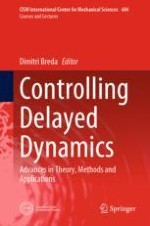2023 | OriginalPaper | Buchkapitel
Pseudospectral Methods for the Stability Analysis of Delay Equations. Part I: The Infinitesimal Generator Approach
verfasst von : Dimitri Breda
Erschienen in: Controlling Delayed Dynamics
Aktivieren Sie unsere intelligente Suche, um passende Fachinhalte oder Patente zu finden.
Wählen Sie Textabschnitte aus um mit Künstlicher Intelligenz passenden Patente zu finden. powered by
Markieren Sie Textabschnitte, um KI-gestützt weitere passende Inhalte zu finden. powered by
